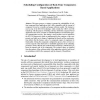1205 search results - page 7 / 241 » From high-level component-based models to distributed implem... |
CVPR
2003
IEEE
14 years 9 months ago
2003
IEEE
Video-based recognition and prediction of a temporally extended activity can benefit from a detailed description of high-level expectations about the activity. Stochastic grammars...
CORR
2004
Springer
13 years 7 months ago
2004
Springer
We describe a scheme for moving living code between a set of distributed processes coordinated with unification based Linda operations, and its application to building a comprehen...
ADAEUROPE
2010
Springer
13 years 5 months ago
2010
Springer
Abstract: This paper proposes a strategy to manage the schedulability of realtime component-based applications that is fully compatible with the concept of component viewed as a re...
AAI
2000
13 years 7 months ago
2000
: As Virtual Environments applications become more complex, there is a need to interpret user interaction in terms of high-level concepts. In this paper, we investigate the relatio...
ISN
1994
Springer
13 years 11 months ago
1994
Springer
There is a common unjustified belief that OSI management technology, despite being very powerful, is difficult to implement because of the complexity of the underlying service/prot...




